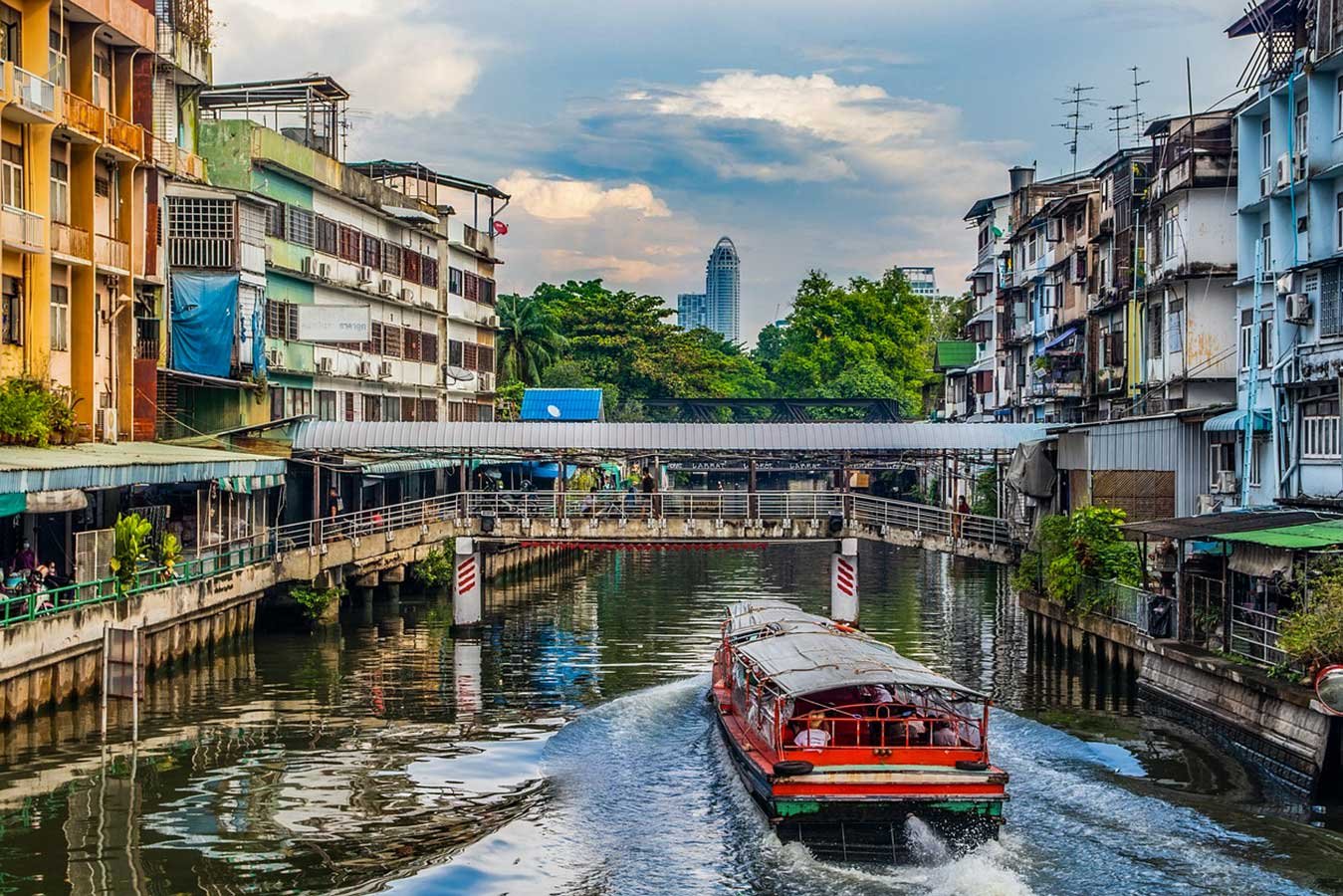How to Use Public Transport in Bangkok (Complete Guide 2024)
This is your comprehensive guide to getting around Bangkok by public transport. Whether you are visiting Bangkok for a couple of days, a week or a month, you will need to navigate around this massive city. So if you want to know how to use public transport in Bangkok, this post is for you!
So you are about to arrive in Bangkok (or maybe you are already there) and you are feeling a little confused by Bangkok’s public transportation. Wondering where to even start and whether the train and metro in Bangkok are easy to use?
I have great news! Using Bangkok public transport is easy! But if you are feeling overwhelmed, I will take you by the hand and show you step by step how to use the Bangkok Metro, Sky Train and other public transport means!

I only use public transport like buses, trains or the metro in any location I travel. It is not only a great way to save money, but also an awesome way to experience local life.
I love sitting on a crowded bus and watching the locals commute, which often comes with a bonus of very unusual experiences. Every country I’ve travelled to has given me a different commuting experience, and I wouldn’t trade it for the comfort of a cab.
But Bangkok has one of the best public transport systems I’ve ever used, and using public transport in Bangkok is very easy.
Table of Contents
What is the Best and Easiest Way to Get Around Bangkok?
The best way to explore Bangkok is by MRT (Metro), Sky Train (BTS) and ferry system. These were by far my favourite ways to get around this incredible and bustling city. All three offer affordable and efficient ways of travelling around Bangkok and cover almost all (if not all) of the sights and attractions in Bangkok.
Many travellers or tourists choose to use taxis or ride-sharing, but I don’t think a Bangkok experience is complete without hopping on the Skytrain at least once!
Bangkok is super busy and during rush hours the traffic is crazy. MRT and BTS are the best ways to get from one part of Bangkok to another while avoiding traffic at any time of the day or evening.

Is Bangkok a Walkable City?
Bangkok can be walkable if you choose the right area for your stay and do not plan to see everything. If you only have two or three days in Bangkok, decide which attractions you want to see and choose the area nearby.
For example. If you just want to see the temples and the Grand Palace, stay in Bangkok Old Town, if you just want to party, stay in Khao San, if you just want to shop, eat and party, choose Siam or some parts of Sukhumvit.
But most likely you will not be able to avoid using public transport in Bangkok simply because the city is just so big. Bangkok as a whole is definitely not walkable.
Pati’s Travel Tip!
Book your accommodation near any of the MRT or BTS stations. Although the MRT and BTS don’t cover the whole of Bangkok it definitely covers most of the parts that are packed full of attractions and sights.
By either MRT or BTS you can travel to places like Grand Palace, Lumphini Park, Siam, Wat Arun or Chatuchak Weekend Market.
It will make your Bangkok experience way easier and more enjoyable!
What Are the Different Transport Means in Bangkok?
Bangkok has an extensive public transport system, and you can travel around the city in many ways.
In Bangkok, you can take the MRT (metro), the BTS (sky train), the Airport Air Link, the river ferry, busses and of course tuk-tuks and taxis.
It sounds complicated but it really isn’t, trust me!
Here is the overview of all available public transport in Bangkok:
Bangkok Airport Link – a line connecting the city centre to Suvarnabhumi Airport.
MRT – an underground metro system with two lines, the Blue and the Purple Line.
BTS – an elevated rapid transit system with two lines, the Sukhumvit Line and the Silom Line, covering many important areas of the city.
Busses – Bangkok has a vast network of public buses covering the entire city.
Bangkok River Ferries – ferries operating along the Chao Phraya River and providing a picturesque way to travel.
Khlong Canar boat taxis – also known as canal boats operate on the city’s extensive network of canals.
After the MRT and the BTS, the ferries were my favourite way of commuting in Bangkok. It’s just so pleasant to sit on the ferry, feel the breeze (especially since I was travelling in the humid season) and watch Bangkok from the river.

How should you decide which mode of transport to use in Bangkok?
It’s really easy to choose what means of public transport you should use at the given time. Google Maps will be your best friend when you are in Bangkok.
Look at where you are and search for the nearest Metro or BTS line. These are very well marked on the map.
Often, when I entered my destination, Google Maps would suggest taking multiple buses, but I learned to look for the nearest MRT or BTS station instead. I’d rather walk 10 or 15 minutes to catch one of these instead of searching and changing buses.
Stations are easy to navigate around, you will find maps with station names and kiosks with someone in there who could always help you. And all of the trains are airconditioned! And run very frequently!
If you are near the river, search for the nearest ferry station. Especially if you are planning on visiting the other side. It’s a great way of travelling around Bangkok.
How to pay for public transport in Bangkok?
To use public transport in Bangkok, I recommend that you always have some small change on you. For the MRT you can use your debit card if you have a visa, otherwise, you can buy a single ticket at the ticket machine or the counter.
For the bus, you can buy a ticket from the ticket inspector and for the ferry from the ticket counter and the ferry station.

How to Use Public Transport in Bangkok
How to Use BTS (Bangkok’s Sky Train System)
The BTS was my favourite way of getting around Bangkok and it is also one of the most popular modes of transport with the locals. I don’t think you can say you’ve been to Bangkok if you haven’t travelled on the Sky Train at least once!
The Bangkok Mass Transit System, also known as the BTS or Skytrain, has two elevated lines – the Sukhumvit Line (light green) and the Silom Line (dark green). The BTS connects major districts and attractions and helps travellers avoid traffic. The two lines – Sukhumvit and Silom – intersect at Siam Station, the heart of the city’s business district.
The Sukhumvit Line runs from Mo Chit (the best station to get off the airport link train) to Samrong, while the Silom Line connects the National Stadium with Bang Wa.
It is also air-conditioned and very well signposted. It’s busy at peak times, but I really enjoyed travelling on the Skytrain and watching the people of Bangkok, both locals and ex-pats going about their lives.
Some BTS stations are also located near the MRT stations and are often connected by elevated footpaths. The BTS also connects famous shopping districts such as Siam Paragon, CentralWorld and MBK Cente.
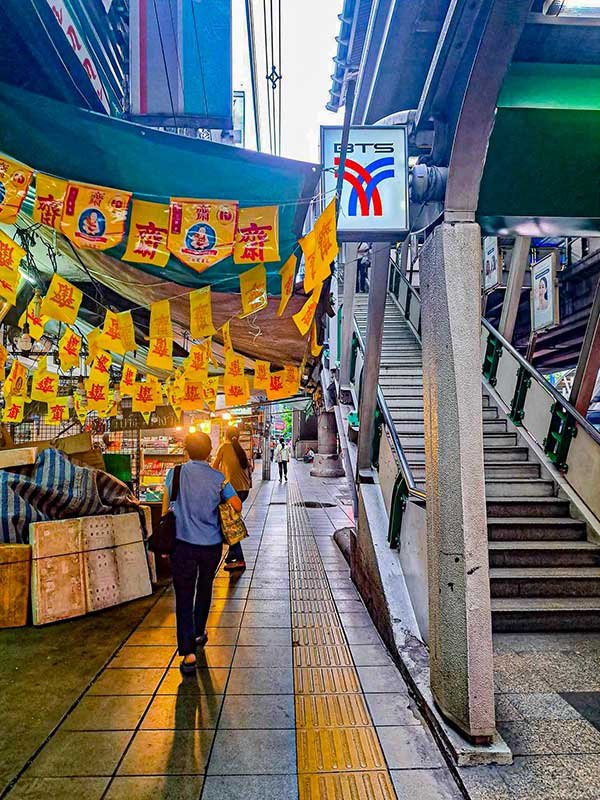
To travel on the BTS, you must buy tickets before boarding, which are available from vending machines in each station or can be purchased at the counters in the stations. The machines accept coins and give change. There is a ticket counter at every station where you can also buy a ticket if you don’t have a change or you can change the banknotes.
You must touch the ticket at the barrier when you enter the platform. Keep the ticket as you will need to at your final destination where you will insert it into the barrier so you can get out.
Fares on BTS range from 16 to 59 Baht for a one-way journey, and trains depart every 5 minutes. I never paid more than 25 Baht for my journey.
How do you know how to get to your destination when using BTS or MRT In Bangkok?
Download the Bangkok public transport map to your phone or take a look at the map that can be found at the station. Locate where you are and then locate your destination station. Trains of course ride in two directions, so to know which direction you need to take check which is the final station. Then follow the sign to that final station.
It is crucial to know which direction you are going when using both BTS and MRT!

For example. You are at the Nana (photo above) station and want to get to Victory Monument.
Victory Monument station is north of where you are, and the final station up north is Khu Khot (photo below). Follow the signs for Khu Khot. Once you are on the train, there is a display showing you what is the next station. Get off at Victory Monument and you are done.
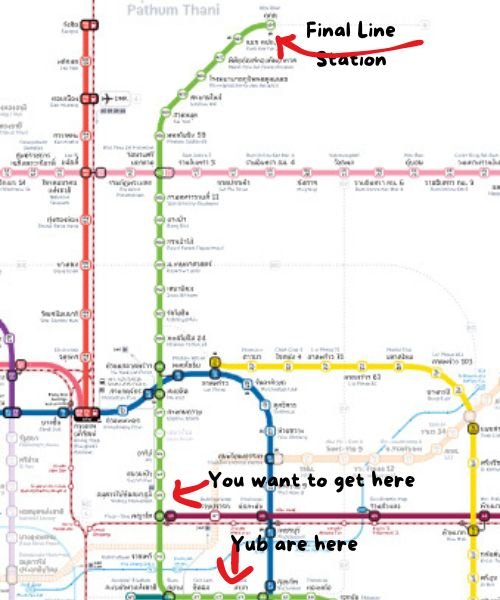

Many stations have multiple exists but they are always going to be well marked and indicate the direction.
This is how to use any metro or sky train system anywhere in the world. The same principle will apply when using MRT.
How to Use MTR (Bangkok’s Metro System)
MRT is Bangkok’s underground metro system, and my favourite part was that I could use my Visa card instead of buying a ticket every time. It was just so convenient!
The MRT covers a large part of central Bangkok and you can travel between places like Old Town, Chinatown, Wat Arun, Sukhumvit, Lumphini Park and even the Chatuchak Weekend Market.
Finding accommodation near one of the MRT stations is one of the best things you can do to make your Bangkok trip easier and hassle-free.
The MRT has two lines – the dark blue and the purple, but you will mainly use the blue one as the purple one connects the suburbs of Bangkok and is mostly used by the locals. The blue line is the one that connects all of Bangkok’s major attractions.
A map of each MRT line can be found at every station.
Here is what you need to know to use the MRT (Metro) in Bangkok:
Plan your route by identifying your destination and the final station in your direction of the MRT line (as explained above)
Many MRT stations have different exits and platforms, but again, Google Maps is a great help. When you enter your destination into Google Maps, it will show you which platform you need to go to in order to get to your desired station.
I only figured it out after 2 days in Bangkok and initially walked around the station a bit confused. Once I figured out that Google Maps indicated which platform to go to and which exit to choose, the whole MRT journey became a piece of cake!
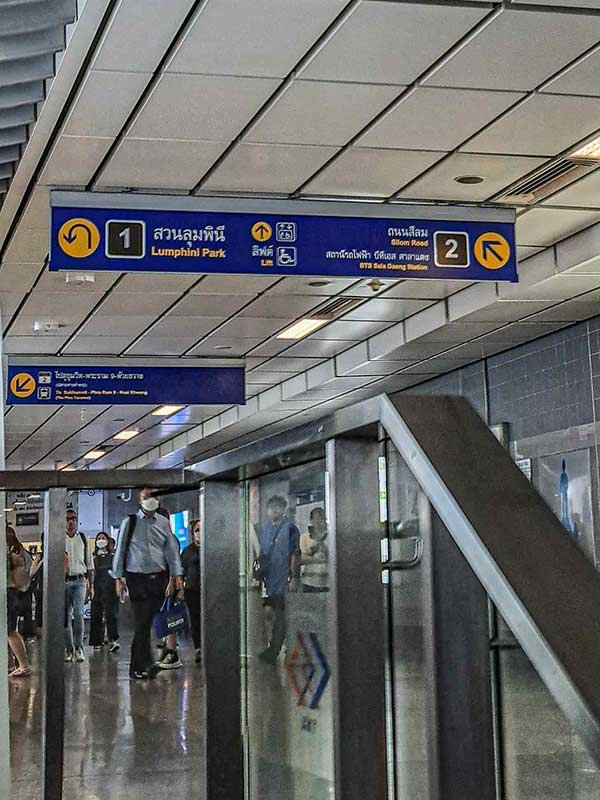
You can buy a token at the MRT ticket machine. You can use both coins and bills, and the change will be given.
If you are not sure, you can also buy your MRT ticket at the station ticket office.
If you think you will be using MRT a lot and don’t have a Visa card you can also get a prepaid MRT Card and top it up so you don’t have to buy a ticket every time you travel. But this only makes sense if you are staying in Bangkok for an extended time.
The machine will dispense the token which you will have to touch on the reader at the barrier. Keep the token. On the way out you will drop it into the slot at the barrier so you can get out.

How to Use River Boats in Bangkok
After BTS and MRT, the Bangkok Chao Phraya Express Boat system is another convenient and affordable way of getting around Bangkok.
Bangkok’s river boats operate along the Chao Phraya River, providing essential connections along the river and between both banks of the Thai capital. The Chao Phraya Express Boat service is not only a highly practical mode of transportation but also offers a delightful means for sightseeing. Many of Bangkok’s key attractions are conveniently situated along the riverbanks.
Be sure to take a trip on a Bangkok river boat at least once! even if just for the experience!

Although using the river boats in Bangkok may seem a little confusing at first, especially because of the different flag colours, believe me, it gets easier with practice.
There are a few things you need to keep in mind when using riverboats in Bangkok:
- There are 5 types of riverboats, each with a different coloured flag: blue, orange, yellow, green and red. These express boats make stops at different piers. Most ferries run on weekdays from 6 am to 10 pm, the orange-coloured one on weekends.
- You can grab your tickets directly at the piers. Sometimes only after you have boarded the boat.
There are numerous piers along the river and different boats stop at different piers. - The Blue Flag line (also known as the tourist boat) is the most popular with tourists as you can take this boat to places like Wat Arun or the Grand Palace. A one-way trip costs 40 baht, or you can snag a day pass for 150 baht.
- When you arrive at the pier Indicate where you want to go and get a single fair.
- I know I sound like a broken record here, but yet again, use Google Maps to plan your journey.
If you want an easy ride, hop on the Chao Phraya River boats after travelling on the BTS to Saphan Taksin. From there you can reach places like Wat Arun, Wat Pho and the Grand Palace or Phra Athit.
For the cheaper option, the Chao Phraya Express Boat with the Orange Flag departs every 10-20 minutes between 6 am and 7 pm and costs 15 baht. It stops at the major jetties from Wat Rajsingkorn in the south to Nonthaburi in the north. For a quick river crossing, countless ferries charge just 3 THB (£0.10) every few minutes, day and night.
If you are staying around Khao San there is an additional route you could enjoy!
Use one of the boat connections on Bangkok’s historic canals, the Khlongs. The Khlong San Saep Express Boat runs through the small canals that lead from Wat Saket near Khao San Road to the Central World shopping mall and back.
Finally, there are also free boates to the ASIATIQUE and ICONSIAM shopping malls. Follow the signs from the Saphan Taksin BTS to Sathorn Pier, which is just a short walk away. When you get there, turn left and you’ll see signs for ASIATIQUE and ICONSIAM — they share the same pier. The boat’s destination is written in big letters so you can’t miss it. Enjoy the ride!
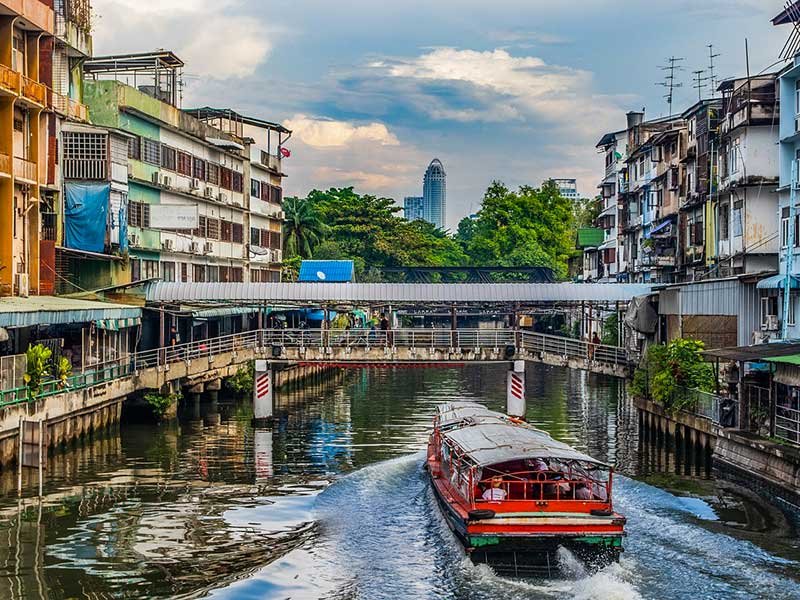
How to Use Buses in Bangkok
The bus system in Bangkok offers an inexpensive way to explore the city, with fares depending on factors such as the bus route, type of bus and travel time. Still, this is my least favourite way to get around Bangkok, and I have only taken a bus once.
Although fares can be as low as 8 baht, buses are often stuck in traffic and what you save in baht, you lose in time and frustration. For this very reason, and because it can be a bit complicated to navigate Bangkok’s bus system, you will not find many tourists on Bangkok’s buses.
There are a few bus companies/bus types you will find in Bangkok and the best way to identify them is by their colour.
Blue and yellow buses are air-conditioned. The red/cream and pink buses only have a few fans. The latter buses are definitely not fancy, with ceiling fans that are sometimes broken anyway, and open windows that are the only “cooling system”.

Bangkok bus ticket fare depends on the bus route, type of bus and time of your journey.
Air-conditioned buses typically have fares ranging from 12 to 25 Baht for a single trip, based on the length of the journey. Regular buses, often have a standard fare of 8-10 Baht.
Buses mostly operate every day from 5 a.m. to 11 or 12 p.m. except cream-red buses operate all-night service.
Purchasing a bus ticket is straightforward. You can buy tickets on board by simply boarding the bus, finding a seat, and paying the conductor. Conductors will come to you, ask you where are you going and let you know how much is the fare.
If you want to get on the bus be sure to raise your hand as buses may not stop if no one signals to board. To get off simply press one of the red buzzer buttons located on the walls or ceilings.
Busses were my least favourite way of getting around Bangkok simply cos I found them confusing, couldn’t always find the bus stop and had to rely too much on Google Maps. But Google Maps will guide you if the destination you want to reach can be only reached by bus.
I have exciting news to share with you, my travel friends!
I have just launched my own Backpacking and Budget Solo Travellers FB Group and I would love you to join me there! Travellers of all budgets and ages are welcome! I would like to create a community where we share tips and experiences and where you could ask me all travel and budget backpacking related questions!
I hope to see you there! Pati
Tips on Using Tuk Tuks And Taxis in Bangkok
I have never hailed a taxi in Bangkok and I don’t recommend you do that either. Both taxis and Tuk Tuks are notorious for scamming tourists and many taxi drivers wouldn’t even turn on the meter.
I am absolutely not saying that this is always the case, but it is better to be safe than sorry. There are a few things you can do to avoid being scammed by Tukl Tuk or a taxi driver.
- Always negotiate the price before starting the journey. Before you even get in.
- Insist on the driver turning on the meter in the taxi.
- Use ride-sharing apps like Grab (the best and safest). This way you will know the fair upfront and you will know the licence plate and the name of the driver. This is by far the safest and cheapest way to travel around Bangkok by taxi.
- If you are determined to use a Tuk Tuk for the experience, be sure to negotiate hard. And don’t allow the driver to offer you additional locations, attractions, his tailor friend, and familiar souvenir shop owner. Those are all scams. Just go where you need to go.
Tuk Tuk tours around the town are also scams. They will just drive you from one shop to another so they can get a commission. If you really want to get a tour, choose a site like Viator or Get Your Guide to do so.
Is There a Public Transport from Bangkok Airport?
Yes, there is! Airport Rail Link is part of the Bangkok Mass Transit System and connects Bangkok Suvarnabhumi Airport with the city. Taking the Airport Rail Link is the most convenient and cheap way of getting to Bangkok centre from the airport. The journey only takes around 30 minutes and the ticket costs xx
How to get to Bangkok City from the airport by train?
Once you arrive at the Suvarnabhumi Airport head over to Floor “B” and follow the signs for the train station (Airport Rail Link/Train to the City). The trip will just cost you 15 to 45 Baht depending on the length of the journey.
Most likely you will have to change into BTS or MRT once you arrive in Bangkok unless your accommodation is near Makkasan, Phaya Thai, Asok or Phetchaburi station.
In order to change for the BTS line get off at Phaya Thai and if you need to change for MRT, get off at Makkasan.
Changing between BTS and MRT as I arrived in Bangkok after 12 hours flight!
Although it sounds intimidating, especially if you just arrived, it isn’t as bad as it seems at first.
I took this journey myself and on the first day I used nearly all the possible means of transport in Bangkok just to get to my hostel!
If you ever used any other metro systems, you will be fine!
I hope you found this guide to how to use Bangkok public transport useful. Dont be afraid of hopping on a BTS or metro in Bangkok. It will be an affordable and convenient way to enhance your bangkok trip!
As always if you have any questions, comment below! I always answer and try to be as helpful as possible!
Until then, enjoy Bangkok and happy travels!
Pati x
Are you looking for more of the off-the-beaten-path Thailand?
Then you should definitely visit the incredibly authentic town of Phitsanuklok!
And while there be sure to visit Sukhothai Historical Park on a day trip!
This post may contain affiliate links which means that if you purchase the product or make a booking via one of my links, I will receive a small commission. Please know that I will never recommend or promote a product I don’t believe in or haven’t used. This way, you are supporting this blog at no extra cost to you. Thank you!

